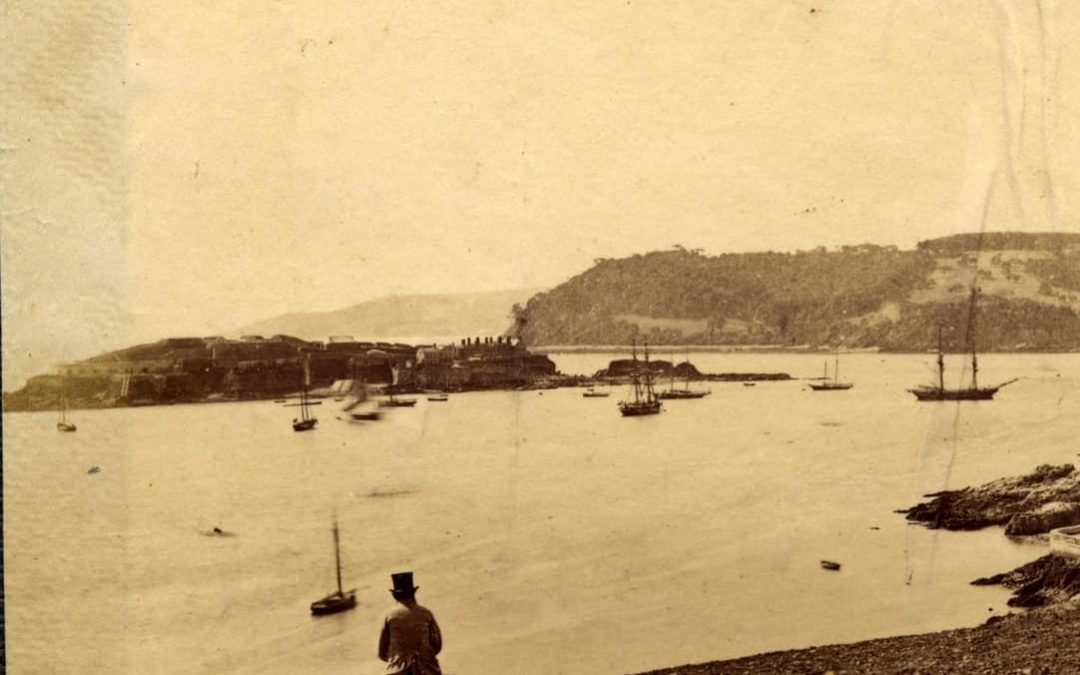The next census in 1871 coincided with the formation of Germany as a country with Kaiser Wilhelm I as Emperor. The next 10 years would see the German Empire expand as it claimed land not yet annexed by the British and French Empires but was wary of antagonising the two older empires. Britain was involved in conflict with the last of the Maori Wars in New Zealand supporting British Allied Maori clans against other Maori clans. The war would finish in 1872 with a victory for the British Allied side although in reality the Maori clans were more interested in expanding their own territory and power at the expense of other Maori clans and viewed the assistance of the British as a way to do it rather than any pro British sentiment. Britain would be involved in a number of other colonial expeditions, conflicts and wars during the next decade.
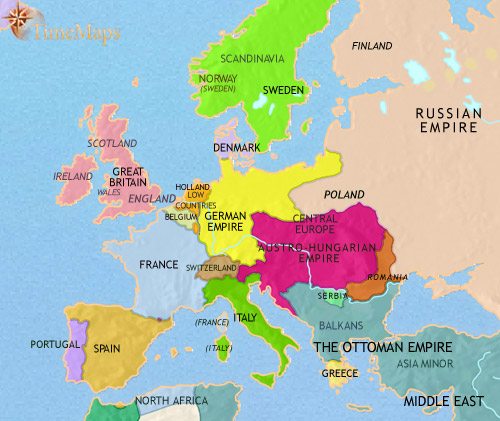
RESULTS OF THE 1871 CENSUS
The 1871 Census provided more information than previously so creates a fuller picture of the Three Towns. Birth rates exceeded death rates in all of the Three Towns as public health had increased over the previous decade. Population figures showed Plymouth was still expanding and had grown by just over 6,000 in the previous decade to 68,833. With just over 7,200 houses inhabited, over 500 were empty, there were over 9 inhabitants per building and families were often limited to only a few rooms per house. Stonehouse had remained fairly static only increasing by 242 to 14,585. Just over 1,300 houses were available meaning there was around 11 inhabitants per house. However the population was predominantly military whose presence had remained the same as previously. Devonport on the other hand had decreased by nearly 1,000 to 49,499. This was put down a reduction in the Dockyard workforce that meant workers moved away to find employment. Even so the area was still overcrowded with over 11 inhabitants per house in the 4,269 buildings. The overcrowding aided the spread of disease and there was a smallpox outbreak towards the end of 1871 that killed 448 people across the Three Towns. It was up to the individual sanitary boards of each of the Three Towns to fight the disease as best they could. General measures included isolation of patients and especially removing them from overcrowded housing. The biggest problem facing the Three Towns was they wouldn’t pool their resources. All three discussed the building of a fever hospital for isolation of patients with all types of infectious disease for their own areas but these plans often fell through as the immediate danger passed or as differences emerged about the location for the hospital and whether it was only for the areas patients or a general admission would be allowed. These types of disputes across municipal boards would continue until the Three Towns merged into one authority in 1914. The Sound and Dockyard was also crowded with 22 Naval Ships in Port including the 1865 Ironclad HMS Agincourt as well as much smaller Gunboats such as HMS Tyrian. There were two Training ships, HMS Liberty with a compliment of 130 including unusually 5 females and HMS Impregnable, the Naval Boys Training Ship which had 421 staff and boys on board, all male including young Boy 2nd Class John Routledge. His Father, Battery Sergeant Major Richard Routledge and his wife Mary Ann along with 8 of their other children made up a sizeable proportion of the 36 people living at the Devon Artillery Militia Store Depot of which only 9 were serving Gunners and the rest families. The eldest Routledge son, William is newly married and living with his wife at 49 Duke Street in Devonport.
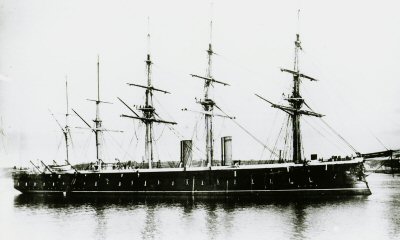
The returns from the various institutions in the Three Towns gives a snapshot of some of the social care, mostly funded by public subscription, that helped those people who had fallen on hard times and needed help to survive. The three Workhouses housed just under 1% of the population. There were 548 inmates in the Plymouth Union Workhouse, 274 male and 274 female cared for by 15 staff, 6 male and 9 female. The Devonport Workhouse had 438 inmates and 17 staff with another 94 inmates in the Stonehouse Workhouse with 5 staff. In addition to the inmates there was also a system of out relief that provided assistance for the poor that didn’t live in the Workhouse. The amount of assistance varied depending on the local Poor Law Commissioners but a report in the Western Morning News of March 1871 from the Poor Law Board returns suggested 1 in 14 Plymothians were in receipt of assistance and in Devonport it was 1 in 29. Various homes for women looked after 87 women, Orphans homes looked after 103 children, the Fore Street Blind Institute cared for 13 people and 77 were housed in the Royal Sailors Home.

In Patients at the various hospitals included 71 in the South Devon Hospital, 3 in the Devonport Female Hospital, 130 in the Royal Albert Hospital and 7 in the Eye Infirmary which was also treating 304 out patients. Militarily there were 174 in the Devonport Military Hospital and 307 in the Royal Naval Hospital.
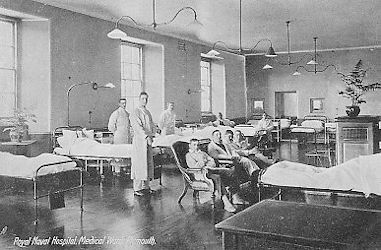
There were separate Police Forces covering each of the Three Towns with around 1 Policeman per 900 people. The Stonehouse area was covered by H Division of the County Constabulary which looked after a wider area than just Stonehouse but the Plymouth and Devonport Forces were dedicated solely to those towns. Those arrested, tried and convicted would often be fined with jail the alternative if the fine couldn’t be paid. In 1871 for example John Ramsey, a Devon Artillery Militia recruit was arrested by PC Lake for fighting with a soldier in the 57th of Foot. On his way to the Police Station he assaulted PC Lake and was bought before the magistrates found guilty and fined 20s plus costs or 14 days imprisonment. With the large number of pubs in the Three Towns drunkenness and assault including against the Police was a fairly common occurrence. Plymouth Prison had 42 inmates. 25 male and 17 female. These were looked after by 14 warders, 7 male and 7 female. Devonport Prison held 74 inmates and had 11 warders. Prisoners whose children would have no other means of support often were sent to the Workhouse.

The Plymouth School Board also took a census with the following findings of children aged 3-13; 1,299 were uneducated, 11,935 were educated, 455 were at work and 864 were not at school. Not everyone would have provided a return but it does give a good idea of what was happening with education in Plymouth at the time. There were 217 schools in total in the district and each provided a return for those at school. The numbers in each would have varied considerably as education was funded by a mix of local and national government funds together with subscriptions and endowments from individuals. The School Board would inspect all types of schools including the larger publicly funded schools and the more numerous privately funded schools. The Devonport School Board census showed there were 9,256 children in the district of which 1,937 were not receiving and education. Plymouth and Devonport had their own Water Companies with their supplies and leats from Dartmoor. Stonehouse drew water from the Tor Spring and was additionally supplied by both the Plymouth and Devonport Companies. The Plymouth and Stonehouse Gas Light and Coke Company provided lighting for 1000 public street lamps lighting the towns and private consumers would pay 2s 3d per 1000 cubic foot of gas for a supply. Devonport had a separate company that lit 450 public lights but charged private consumers 1s more per 1000 cubic feet for a supply.
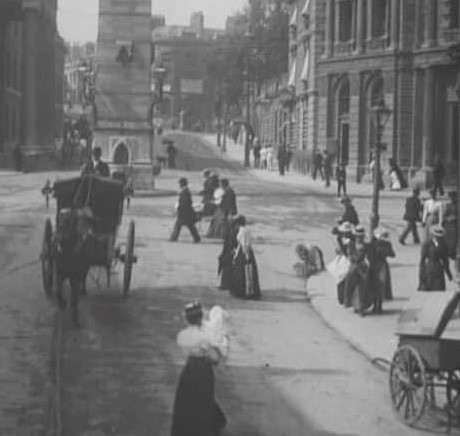
To get around the Three Towns there were horse drawn carriages and buses, the local boatmen and shank’s pony. The Toll bridge across the creek linking Stonehouse and Devonport cost 1d on foot and 2d for a carriage. For travel further afield there were Steam Packets running regular routes from the Great Western Docks. Destinations within Great Britain and Ireland including the Channel Islands tended to run at least weekly. Europe, Australia and South Africa had monthly routes. Locally in 1871 the Oreston and Turnchapel Steamboat Company was founded from the two separate companies. They ran ferry services from Sutton Harbour to Hooe and later added Oreston using 4 boats, the Greyhound, Eclipse, Beagle and Lightening. The Crew was fined 1s 6d if the boat left more than 5 minutes late. Pleasure cruises to various destinations around the Sound were also being run. One story appeared in the newspapers during August 1871, the steamer Volunteer returning from a trip around the Eddystone Lighthouse with 900 passengers ran aground on the Eastern side of Drake’s Island. The lighthouse on Eddystone at the time is the current Smeaton Tower on the Hoe. Several boats came to the Volunteer to take the passengers off and the Volunteer was eventually floated as the tide came in. The Captain was later charged and found guilty of wilful neglect in respect of not having a boat (a lifeboat in case of emergency). The Captain who earned 30s a week (£1 6s) was fined £25 with costs or 3 months imprisonment. Plymouth was busy not only with local ferries and pleasure steamers, the Royal Navy but also a significant amount of commercial shipping. Early in 1872 the Brigantine (a 2 masted sailing ship) Forest King ran aground on the east end of the Island on her way out of the Sound. She was got off on high tide and recovered to Sutton Pool for survey as she was taking on board a lot of water.
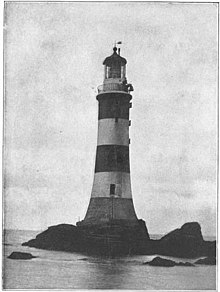
The Garrison on the Island was provided by a detachment of around 40 Gunners from the 13th Brigade of the Royal Artillery. Interestingly the Census report noted that neither Drake’s Island or the Plymouth Breakwater and Lighthouse belonged to Plymouth but were extra parochial and extra municipal in character meaning they were administered by Plymouth but not considered part of it. This supports the view that the Island was owned by the Duchy of Cornwall and was the conclusion come to when the Army left in the 1960’s and the Island was returned to the Duchy. The Island was still supplied by civilian contractors applying for the tenders put out by the Commissariat in the Papers. The contract length varied between 3 months and a year depending on what was being supplied. In June 1871 Gunner Saunders was tried by Court Martial for striking Sgt Goode and being absent without leave from the Island, a fairly common case as u to 10% of the Army would be absent at any one time although the numbers would fall as the recent Cardwell Reforms of the Army began to take effect. Unsurprisingly Gunner Saunders was found guilty and Gunner Seaward who had given evidence on behalf of Gunner Saunders was immediately arrested and taken to the Island to be charged with wilful and corrupt perjury!! The 13th appeared to send their bad boys to the Island and a few months later Gunner Mason was charged with being drunk, Cpl Locking and Gunner Bromsden appeared for the prosecution and Gunner Mason who had a bad character and had been convicted on a number of previous occasions was duly found guilty.
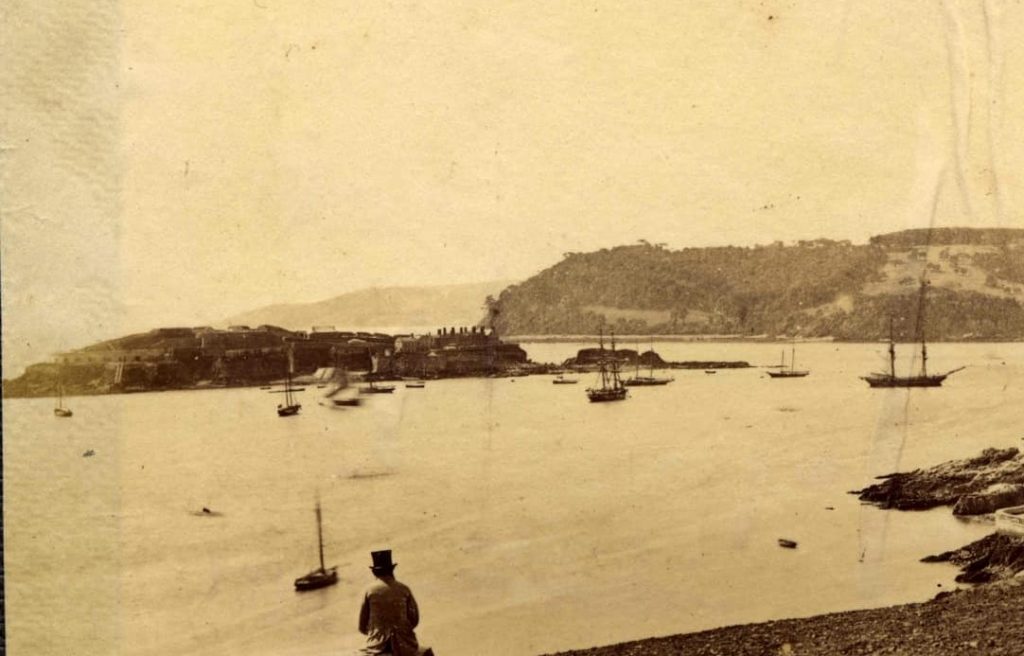
THE YEAR 1872 CHILDREN AND A GRANDCHILD FOR THE ROUTLEDGES
1872 saw the 11th child born to Richard and Mary Ann who they christened Albert Thomas. Of the older children living at home Emily Emma was working as an uphoslteress, Eliza was helping to run the home, Annie was training to become a teacher, Frederick had got a plumbers apprenticeship and Maud was an apprentice milliner. Rosina and Charles were still at school. Richard and Mary Ann also became Grandparents for the first time in the same year when their eldest William and his wife Caroline had a baby girl who they christened Thirza. By this time they had moved out from the in-laws and into rented rooms at 62 George Street. The house was shared with 3 other families. John, the second born of Richard and Mary Ann was now in his last year of boy training aboard HMS Impregnable and would soon be posted to his first ship.
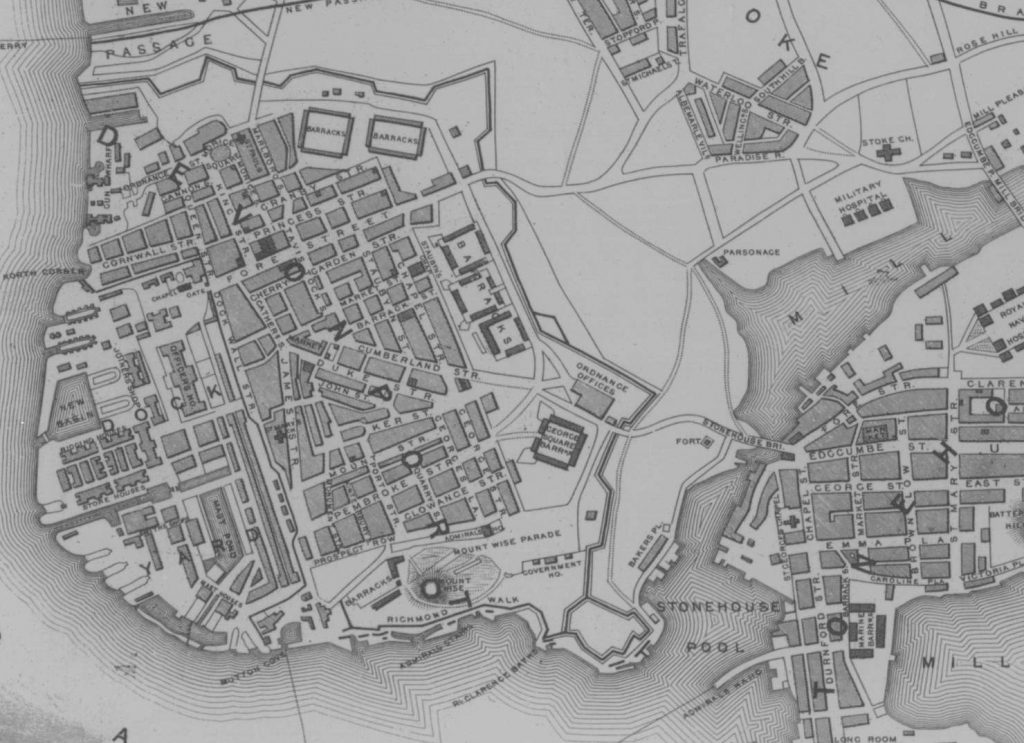
THE FIRST FA CUP FINAL
The 1st FA Cup Final was also played in 1872 at the Kennington Oval in London between The Wanderers, a team of ex Public School Boys and the Corps of the Royal Engineers with The Wanderers winning 1-0 with a crowd of 2,000 watching. The Engineers team was made up solely of Officers and played most of the match with 10 fit men as one of their players, Lt Edmund Creswell was injured early in the match and there were no substitutes allowed although Creswell did stay on the pitch. Another rule of the time was teams swapped ends after each goal rather than at half time and the goals had neither crossbars or nets!!
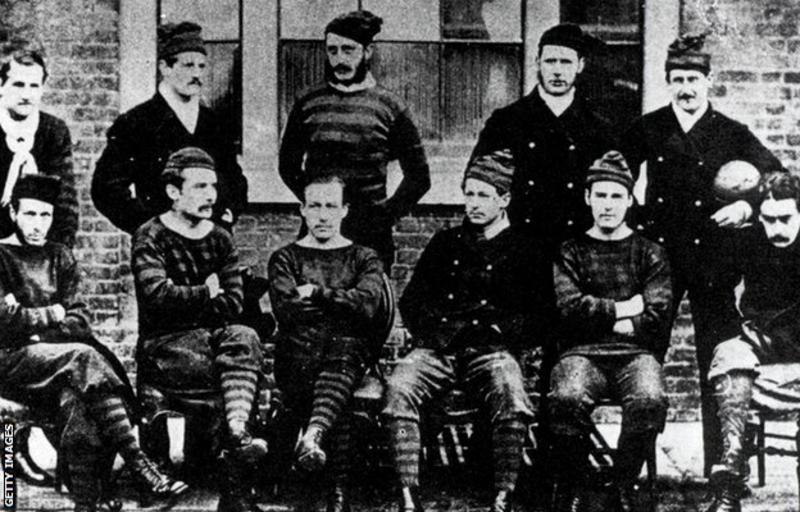
25 TON GUNS ARRIVE AND GOOD FISHING OF DRAKE’S ISLAND
April of 1872 saw the 25 ton guns arrive and bought onto the Island. The Iron Blast Shields still hadn’t arrived so the ramp constructed by the Royal Engineers which was designed to take 25 ton guns could still be used. The carriages had arrived on the Island the previous year. The Gun would use around 67lbs or 30kg of gunpowder to fire a 600lb (275kg) armour piercing shell through 15 inches of steel at a Kilometre. Shrapnel or common shells weighed in at 497lbs (225kg) and required 50lbs (23kg) of gunpowder. The reload time for a well trained crew was 5 minutes. When the Garrison was off duty there was good fishing to be had off the Island throughout the year and some of the Garrison would take advantage by fishing from the foreshore. In the summer of 72 it was reported 3 large Dog Bass weighing an average of 71 lbs had been caught using Rod and Line from the Island. Not long after in October Number 3 Battery, 12th Brigade of the Royal Artillery rotated to the Island to begin their stint as the Island’s Garrison.
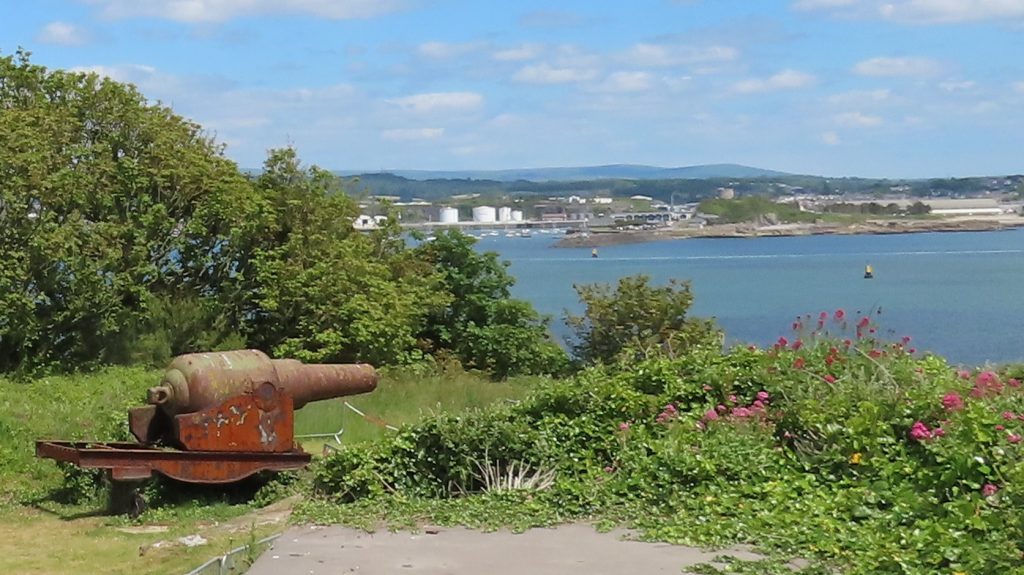
PLYMOUTH GETS BRITAIN’S FIRST STREET TRAMWAY
Back over in Plymouth the first street tramway in Great Britain started operating in 1872. Constructed and run by the Plymouth, Stonehouse and Devonport Tramways Company it ran from Derry’s Clock via Union Street to Stonehouse then over Stonehouse Bridge to connect to Devonport Hill before terminating at Cumberland Gardens. The first day of operation was given over to free rides with the Emerald and Cream coloured trams pulled by 2 horses except for the steep Devonport Hill that required another 2 horses.

1873 THE 3RD ASHANTI WAR
Britain had bought the Dutch Gold Coast (present day Ghana) a year earlier in 1872 which had upset the trading relationships that had existed to the detriment of the Ashanti who invaded. British Arms manufacturers seizing a trading opportunity sold weapons to both sides but the Ashanti were defeated after a short campaign. The British then imposed free trade on the Ashanti and took a one off tribute or reparation of 50,000 gold ounces.
TWINS BORN ON DRAKE’S ISLAND
On the 23rd Feb 1873 – John Henry and his twin brother Edwin Charles were born to Sergeant Abraham Allen and his wife Amelia on the Island. Abraham was serving with the 12th Brigade detachment forming the Garrison. They had 3 older sisters and an older brother. The family was next posted to Valetta in Malta with the Brigade where a younger brother came along while the twins were at school. The family was then posted to Southsea where Abraham was appointed the Barrack Sergeant. The boys finished school in Southsea. John stayed in the Portsmouth area working as a Blacksmith’s Mate and later qualified as a Striker on the Railways. He married Ann with who he had 2 daughters and a son. Edwin followed his father into the Army enlisting as a boy in the Royal Artillery in 1888 but was discharged the following year on the reorganisation of the Royal Artillery whilst still a boy soldier as services no longer required. Like John he settled in the Portsmouth area and got married to Sarah. There is no record of any children. For a time they share a house with his older brother by 2 years William and his wife Kate with their daughter Kathleen. Both Edwin and William were working as labourers.
MUTINY ON DRAKE’S ISLAND
There are slightly conflicting reports about the causes of the mutiny but it made the national news for a few months as the first reports emerged and went on throughout the court martial and sentencing of those involved. The Island was garrisoned by a detachment of the 12th Brigade Royal Artillery. At the time the men usually took leave over the winter and would all be back for the spring to start the annual round of training. In April the detachment was ordered to parade by the Battery Commander Major Cummings in marching order with their full kit. The Parade Square would have been at the top of the Island where the Upper Battery was situated. After the men were inspected their kit was checked. Some items were missing from a number of knapsacks and 8 men were selected for 3 days extra drill and ordered to attend defaulters parade alter that day. When the defaulters bugle sounded none of the defaulters paraded. A general assembly was then sounded for the whole detachment to turn out. The 8 defaulters were then questioned and said that some of the missing kit had never been issued – a not uncommon occurrence – and that it was unfair that 8 men had been selected for punishment when many more had missing equipment. The 8 were then ordered to be punished by 7 days extra drill. At a following parade the men were late and the punishment was increased by another 3 days to 10 in all. The men were then dismissed.
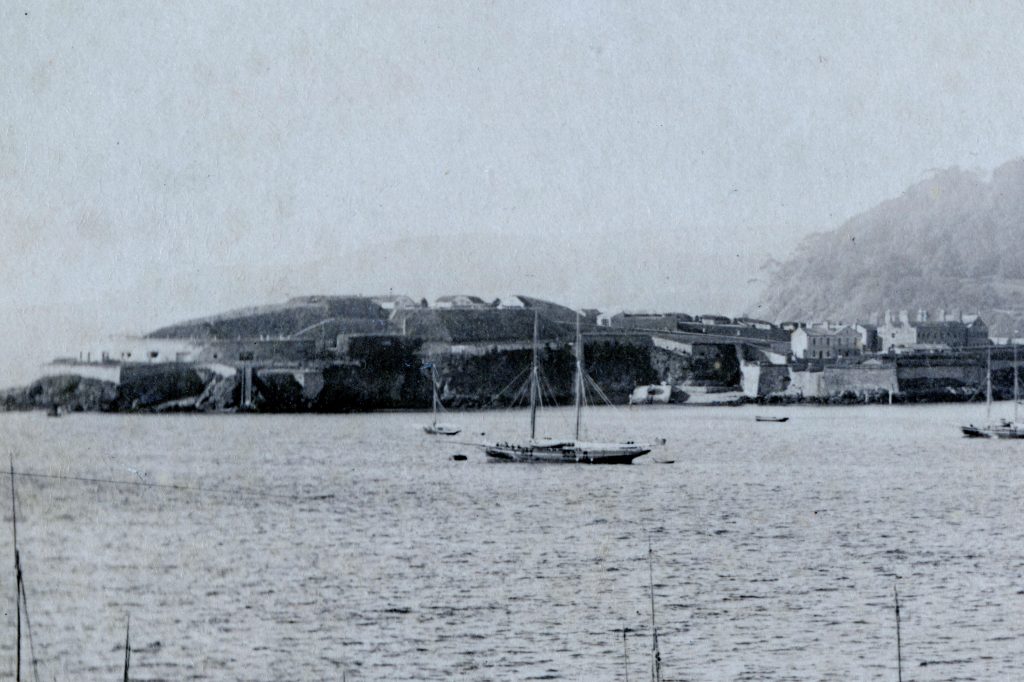
Most of the off duty men spent the evening in the canteen bar drinking. As they left they were seen by Battery Sergeant Major Evans returning to their barrack room undoubtedly the worse for wear. The BSM met Sergeant Grounds at about 9.30pm and told him to arrest Gunner Mullet who was drunk. Sergeant Grounds got together an escort from the Guard but on entering the barrack room Gunners Burnside and Davis stood between the guard and Gunner Mullet. They shouted they were not slaves and would not allow Mullet to be taken. The rest of the barrack supported them and the lights were extinguished at which point Sergeant Grounds decided he had insufficient force to arrest the men and withdrew. Other reports said a fight broke out and the guard was physically beaten back. As Sergeant Grounds got together a stronger guard a commotion was heard in the barrack room caused by the men were shouting and singing as they broke windows, furniture and some carbines. There was no armoury as such in those days. The men kept their carbines, a shortened rifle used by Dragoons and Artillery, in racks in their barrack room although the powder and shot was kept in a locked or guarded magazine. The reinforced guard entered the Barrack but decided that it was beyond their ability to stop the riot as the men had armed themselves with swords (bayonets) and were threatening anyone who approached. The Guard was then ordered to lay siege to the barrack block. Gunner Burnside reportedly rushed out with a carbine and sword but was overcome after a desperate struggle. Other men now started to try and escape by jumping out of the windows but were arrested by the Guard. Eventually 6 gunners were arrested although they were not all part of the original 8 selected for punishment. One of those arrested was actually part of the Guard, Gunner Pearse, who Sergeant Grounds said had not taken Gunner Mullet who was drunk and confined him when ordered to do so.
4 men, Gunners Burnside, Hammond, Mullet and Cook were charged with mutiny, drunkenness and breaking carbines and windows the property of the government. The court martial was presided over by Colonel Forbes RM and Colonel Cary, the Adjutant General prosecuted. Gunner Burnside was a lawyers clerk before enlistment and took the lead in defending their actions during the court martial. The prisoners defence was that they could not attend the defaulters parade as they were on barrack duty and did not have enough time to get into marching order. They also claimed the subsequent punishments meant they were goaded to desperation by the petty tyranny of Major Cummings. They also claimed they were not part of the disturbance and could not be identified as the room was dark and lights extinguished. One Gunner claimed he was dead drunk and knew nothing of the disturbance and therefore couldn’t have taken part. Colonel Forbes ruled all this evidence was inadmissible as it was mitigation and not proof the men did not mutiny.
Gunner Davis was also charged with mutiny but court-martialled separately as he was not charged with damaging government property. All five got five years penal servitude with the four also charged stoppages for damage to government property and Gunner Davis fined £1 for drunkenness. Gunner Pearse was found guilty despite being of good character and having a good conduct badge. His defence was he never heard the order as the commotion in the barrack room was too great. As was usually the case his word was not believed against that of a superior rank, in this case Sergeant Grounds.
Horse Guards had the promulgation of the sentences deferred pending an inquiry into the conduct of Major Cummings but on 23 June the whole of 12th Brigade paraded to hear sentences confirmed on Burnside, Cook, Hammond, Mullet and Davis. In August newspapers reported the sentences had been commuted to discharge from the Army. Some later reports said the discharge was referring to on completion of the sentence and I can’t find a definitive answer one way or the other at the minute. Major Cummings and some other Officers were quickly moved to other posts during the inquiry. A running joke in the Army to this day is that when soldiers get punished it is fines and jail but for the Officers they are punished by promotion and posting!! A little later 12th Brigade would be replaced by a detachment of 10th Brigade on the Island.
Before that rotation happened yet another Gunner from 12th Brigade, Gunner Browning found himself court martialled. He broke out of the barracks Drake’s Island whilst confined there, managed to get to the mainland and went on the run. He pleaded guilty and received jail time, his character was described as very bad by the Officer defending him.
In June there was a major landing exercise planned involving 3 Brigs and 30 other boats landing 6 Field Pieces and 2,000 men to storm the defences. Such was the public interest in these large scale exercises that the Army could charge the Public admission to watch, in this case 1s.
DEVON ARTILLERY MILITIA REORGANISED
July saw confirmation of a Brigade reorganisation of the mobilisation plan for the Devon Artillery Militia. This would have involved some considerable staff work by Richard and his colleagues at the HQ in the Devon Artillery Militia Stores Depot. Each Artillery Company was now assigned a specified post or fort for service when called up. Their role as Garrison Artillery was to defend the Coast and man the defences in their Area of Responsibility. There were 12 companies in all which would form up across South Devon in their home town and then deploy to the defences in Plymouth, Two Companies were assigned to Drake’s Island. This didn’t affect the annual training which remained at the 27 days Annual Camp with weekly drill. New recruits would have an additional training, up to 8 weeks, prior to the annual camp as before.
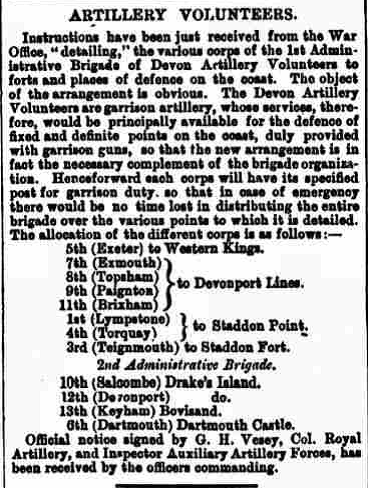
12TH BRIGADE POSTED
In October 12th Brigade after leaving a trail of destruction behind them departed Plymouth for Malta. To be replaced by 17th Brigade who coming to Plymouth from Woolwich. From November they would have had the responsibility for firing the time gun from the Island at 0630, 1300 and 2030hrs Greenwich Meantime. The firing of the Guns was critical for maritime navigation as the exact time at the Greenwich Meridian was required to accurately plot longitude. Mariners would therefore set their watches by the firing of the gun.
1874 THE FIFTH GUILDHALL OPENED, TRAM LINES EXTENDED
The foundation stone for the fifth Plymouth Guildhall was laid in 1870 by the Mayor William Luscombe. It was opened by the Prince of Wales, the future Edward VII in August 1874. The Fore Street Devonport Tram Terminus was built in the same year as the horse drawn tram route was extended by a one way loop from the old terminus at Cumberland Road, up Chapel Street onto Fore Street and back to Cumberland Road via Saint Aubyn Street.
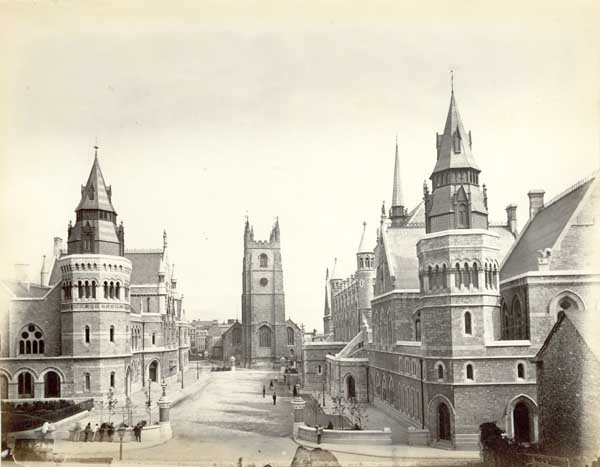
Over on the Island there were still ongoing discipline issues. In April Gunner McGill pleaded guilty at Court Martial to being drunk on Drake’s Island and making away with several articles of his kit. It was not uncommon for soldiers to pawn their kit to get money for drink or gambling and Gunner McGill was described as having a bad character. By this time it was becoming clear that the Palmerston Defences and their Rifle Muzzle Loaded Guns and armaments would soon be outdated by the production of more powerful and accurate breech loading guns which were loaded much more quickly. The reports vary a little but no more than 13 of the 21 nine inch twelve ton guns were ever delivered, In June alterations and additions to magazines and stores on the Island began. There is no detail of exactly what the changes were but we know those casemates that did not have guns were converted to be used as stores and workshops by the time an 1895 survey was carried out by the Royal Engineers. In the summer as part of their annual camp the Duke of Cornwall’s Artillery Volunteers were on the Island for training including how to mount a 25 ton gun. A little later in September Master Gunner MacDonald arrived on the Island to take over from Master Gunner Thomas Hillyard who had left for Canada a year or so previously.
A SECOND GRANDCHILD FOR RICHARD AND MARY ANN
In the third quarter so between July and August Caroline, William’s wife, gave birth to their second baby, a boy who they christened William John.
MASTER GUNNER DEFRAUDS THE WAR OFFICE AND ABSCONDS
In March it was reported that the Master Gunner of the Island, MacDonald had absconded and the tale has a touch of the Reggie Perrin’s about it for anyone who remembers that TV Sitcom. Essentially the Master Gunner had been posted the Island the previous September. He had responsibility for the maintenance of the guns and it seems he started to order a lot of cordage for traversing the guns and spare ancillary items such as iron gun sights. As the stores arrived on the Island they would be shipped back to Plymouth to be sold on the black market. He even used some of the Garrison and the Island boats to help him move the stores back to Plymouth. It seems the authorities realised after a while there was an excess of stores being held on the Island and sent a couple of officers to do an audit and interview the Master Gunner. However on arrival they found no stores and the only trace of the Master Gunner was his clothes left on the Landing Place on the foreshore. The Officers couldn’t figure out what had happened to the Master Gunner, had he drowned in trying to make his escape, swum to the mainland or a boat it was a mystery without a lead. However a month later all was revealed as the Officer Commanding Drake’s Island received a letter from the Master Gunner all the way from America where he was living off his ill-gotten gains!!
The Garrison did seem a little out of control at this point. In May Gunner Christie was charged in the civil court with being drunk and assaulting both the wonderfully named Seaman Trout of HMS Cambridge and the arresting officer PC Barker. One of the Artillery Officers accompanying Gunner Christie described his character as indifferent with which he was sentenced to 6 weeks hard labour. After he completed his civil sentence he would be returned to military custody for any further charges. The same month Gunner Smith pleaded guilty at court martial for desertion from Drake’s Island and making away with his kit. However this was just a regular part of military life in the Three Towns as was the Inspection of the Devon Artillery Militia a few days later. It would be one of a number of inspections held throughout the year as various officer from the Commanding Officer up to Brigade and Divisional Commanders would inspect the troops, their kit and watch them on various drills. This was partly necessary for the Militia so they could be signed off as fit for purpose. One piece of sad news from the Island was the wife of Albert Wodehouse gave birth to a stillborn daughter on the 24th May.
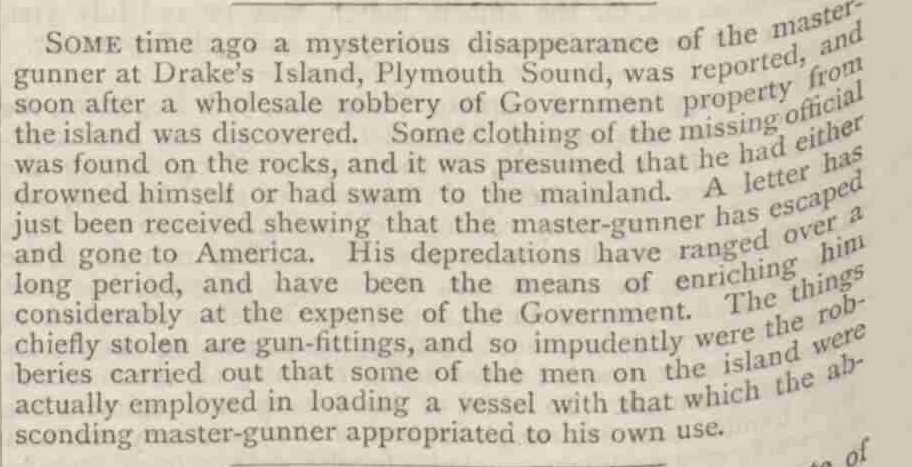
1876 PLYMOUTH RFC AND DEVONPORT ALBION RFC FORMED
As people slowly were getting more leisure time and travel times were reduced sport began to play an ever increasing and popular part in life. Both clubs were founded in 1876. Plymouth played at South Devon Place and wore Green and White shirts. The entrance was off Mainstone Avenue close to the current Astor Park and parallel with Embankment Road. Devonport Albion was formed by a group of Dockyard apprentices and initially played at Devonport Park wearing Cherry Red and White shirts. The clubs would later merge after World War One to form the current Plymouth Albion RFC.
DEVONPORT SEAMAN’S MISSION OPENS
The Mission was opened by Miss Agnes Weston who had previously set up a number of similar missions in Portsmouth. Agnes was an active member of the National Temperance League (a Christian anti-alcohol movement) and by coincidence the British Women’s Temperance League formed this year also. They had quite a task as when the mission opened there was around 1 pub and beer house for every 170 people, man woman and child in the Three Towns!! Temperance societies had been around in the Three Towns since the1830’s and a rough estimate would be there were 2,000 members across the Three Towns out of a total population of around 130,000. Agnes campaigned to improve the conditions of sailors and their families and along with the other Temperance Societies mounted campaigns to at least regulate the alcohol trade more strongly and to turn individuals away from drink which was often done by getting people to sign pledges to abstain from drinking. There was considerable opposition from the alcohol trade and not least because of the military nature of the Three Towns. Even back then boy sailors were entitled to the daily rum ration which gives an idea of how alcohol was part of everyday lives. The campaigns eventually led to a little tightening of the regulations and a harder line taken by the Police towards drunkenness.
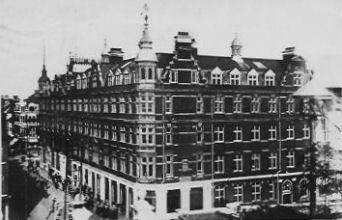
FIRST FREE PUBLIC LIBRARY OPENS
The first free Public Library in Plymouth, known as the Borough Free Library, opened in 1876. The site was the old Guildhall in Whimple Street that became available after the new Guildhall opened. It was converted by a Plymouth Builder, Robert Stanlake. Funds raised included £300 from the Council and £1100 in subscriptions. 5,000 books were either bought or donated and Mr William Wright was appointed as the Librarian. The Library was open 6 days a week from Monday to Saturday. The Newsroom opened at 9am and the Lending Library and Reference Room at 10am. All shut at 10pm. The Western Morning News described the layout as follows “The western and semi-circular end of the old Guildhall, where the magistrate’s benches formerly stood, is a public lobby fitted with seats, with the librarian’s desk and counters immediately opposite. The public pass between the counters to the body of the room, which is provided with tables and chairs for readers. The bookcases occupy the available spaces on all sides. Immediately under the barrier are the hot water pipes for heating the room. The bookcases are of pitch pine, and the tables of oak, and all the fittings have been specially designed for the building. The adjoining newsroom is conveniently fitted with tables and newspaper stands. The wall plastering throughout is tinted green, which contrasts well with the colour of the woodwork. In the heads of the windows are some interesting fragments of stained glass from the Guildhall, built in James the First’s reign. The alterations have been well carried out by Mr Stanlake, builder, from the drawings and instructions of Mr Hine, the honorary architect. Mr Stephenson fitted the hot water apparatus, and Mr Whipple has done the gas fittings. It is certainly not saying too much, and, indeed, it is not saying enough to remark that Mr Eveleigh’s Guildhall was never seen to so much advantage as it is now. The exterior, however, is still unattractive.”
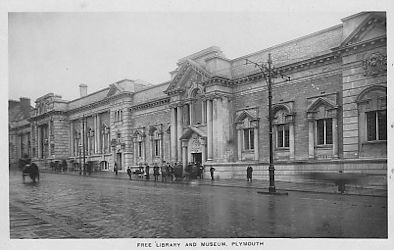
ANOTHER ROUTLEDGE IS BORN
Late in the year William and Caroline welcomed their third child into the world. He was christened Alfred Ernest.
1877 A NEW RAILWAY STATION OPENS
The Cornwall Railway Company and South Devon Railway were incorporated into Great Western Railway and the Sutton Harbour branch line opened the previous year. Millbay Station was now owned and run by GWR. The railways were expanding all the time and the issue was complicated by competing railways often resorting to the law to get rights over the lines and that narrow and broad gauge tracks were used. In 1877 GWR was coerced by the London and South Western Railways to build the Plymouth North Road Railway Station. LSWR wanted a Plymouth Station to link into their Devonport Station. GWR didn’t want or need another Plymouth Station but the London Company who had recently gained the running rights over one of Great Western’s lines running into Plymouth from Cornwall had the legal right to force them to build a Station that could be jointly run. The Station after delays was opened in March and the first Station Master was Mr Albert Pearse.
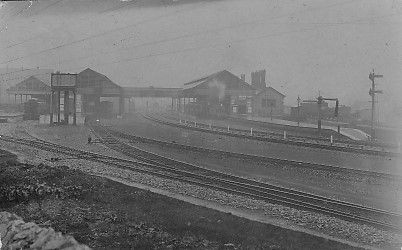
THE 9TH XHOSA WAR
This was the last of the 9 Xhosa wars that began back in 1779 and had flared up intermittently over the next century. In South Africa the Colonial Governments were relatively independent and pursuing relatively harmonious relations with the indigenous peoples. The Cape Colonial Government had a mutually beneficial relationship with the Xhosa Nation. However the British Government wished to dismantle the independence of the Colonial Governments and bring the local nations under direct British rule. The pretext for war was an attack on a colonial police outpost that the Colonial Government believed was a local police matter but the British Representative and local radical settlers who wanted cheap Xhosa labour used as an excuse for the conquest of the neighbouring independent indigenous state of Gcalekaland. The justification was increased by unfounded rumours of a Xhosa invasion. The conquest lasted only 3 weeks after which the British wished to disarm all the indigenous populations of the Cape. The Cape Colony Government objected and was disbanded. This led to a general Xhosa uprising which took over a year to put down and then only after the British adapted their tactics. The war finished in 1879 and was the forerunner to the Zulu war.
ADDITIONAL MILITARY FERRY SERVICE FOR THE ISLAND
A new regular service for the military provided by a Government Cutter running between the Island and Millbay began in 1877. The Island boats were still needed for supply runs to Royal William Yard and in emergencies. The soldiers could also still make use of the Island boats or private hire from one of the harbours for their own recreational use especially social and shopping trips to Plymouth. However they were not well trained sailors and the weather still caught them out on a regular basis. In February three Gunners set forth in bad weather from the Island. The weather quickly worsened into a gale and their boat was driven past the breakwater and out to sea. The newspapers reported them missing and there were fears they had been drowned. Fortunately they turned up two days later having made landfall further down the coast they marched themselves – to save walking – back to Plymouth and reported to their HQ at the Citadel before being taken back to the Island.
ANNUAL MILITIA CAMP AND MAJOR DEFENCE EXERCISE
Annual Camp for the Militia was conducted at Tregantle Fort and under canvas during May. However it wasn’t just the Militia that would be worked and inspected. The Commander Royal Artillery Western District, Colonel Newton, inspected the Island in late May. The Regular companies garrisoning the various forts around the Sound were bought to the Island and were inspected as they operated the guns culminating in each gun firing a blank round, thought to be the first time all the guns had fired on the same day. This was a prelude to a major Naval exercise whereby the Channel Squadron would play the enemy and attempt to get past the newly constructed Palmerston Fort defences and their guns. This would start to be a regular occurrence in exercising the defences of Plymouth over the coming years which would also prove to be a great spectator sport for the population of the Three Towns.
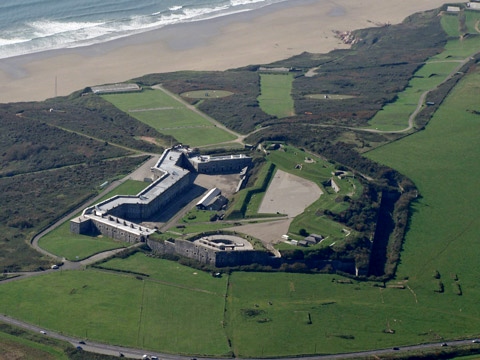
1878 RICHARD AND MARY ANN HAVE THEIR TWELFTH CHILD, WILLIAM AND CAROLINE THEIR THIRD AND THREE MORE ISLAND BIRTHS
Richard and Mary Ann had their twelfth and last child, a baby girl who they christened Lilian Violet. In June Caroline also gave birth to a baby girl who she and William named Blanch Mary. Over on the Island there were 3 births during the year. Alice Charlotte Garrod was born to Sergeant Henry Garrod and his wife Maria. Henry was serving with 3rd Brigade at the time but shortly after Alice was born was transferred to 6th Brigade and posted out to India. Alice was actually baptised in Aden the following year. Alice was their second daughter with Annie her older sister born in Dover 4 years earlier not long after Henry, who was originally from Ipswich married Maria who was from Dover. Henry was discharged on medical grounds and the family ended up in London by the 1891 Census. Henry was now working as a labourer and Maria had another four children making six in total. Alice married a few years later in 1897 but it is not clear to who. Martha L Lyons and John J Thomson were also born on the Island and are listed as such in the Armed Forces Register but with no other details than they were born on the Island and the regiment was the Royal Artillery. It is likely they were all serving with 3rd Brigade but unfortunately I can find no more records at the moment.
POLICE REPORTS FOR THE THREE TOWNS
The reports provide an interesting snapshot of the Police and what they were dealing with at the time. In Plymouth the force consisted of 86 Officers made up of a Chief Constable (paid £250 pa), Superintendent (£130 pa), 5 Inspectors (£80 pa each), 7 Sergeants (27s per week each), 72 Constables (18s per week each). They policed 149 Pubs, 150 Beer and Cider Houses, 18 Refreshment Houses with Wine Licences and 11 Grocers allowed to sell alcohol. There were 51 assaults on the Police, 53 serious or Indictable Offences, tried by jury for which 30 arrests were made and only half went to trial. There were 1,043 minor or Summary Offences which could be tried by a magistrate without a jury of which 795 resulted in convictions with 423 fines and 351 prison terms handed out. 41 were otherwise punished. In addition there were 337 arrests for drunkenness or Drunk and Disorderly which resulted in 289 convictions. Over in Devonport there was a force of 50 Officers headed by a Chief Constable (£140 pa), 3 Inspectors (£78 pa), 5 Sergeants and 1 Detective Sergeant (26s 6d per week), 39 Constables and 1 Detective Constable (20s per week). The Detectives would be on uniformed duties if not working as detectives. Their beat included 122 Pubs, 95 Beer and Cider Houses, 11 Refreshment Houses with Wine Licences and 9 Grocers allowed to sell alcohol. Over the year there were 35 assaults on the Police, 25 serious or Indictable Offences, tried by jury for which 20 arrests were made and only 8 went to trial. There were 610 minor or Summary Offences of which 520 resulted in convictions with 308 fines and 173 prison terms handed out. 39 were otherwise punished. In addition there were 121 arrests for drunkenness or Drunk and Disorderly which resulted in 119 convictions. The return for H Division of the County force which covered Stonehouse covered the whole of the Divisional area so there are no exact numbers for Stonehouse.
51st PLYMOUTH CORPS OF THE SALVATION ARMY FOUNDED
The Salvation Army which was founded in 1865 came to Plymouth in July 1878 when the 51st Corps was founded adding to the charitable organisations working within the Three Towns. In an age before any real social security net these organisations were needed by the poorest in society although they could have conflicting aims and were in competition for subscriptions and funds to finance their work. The first meeting chaired by Captain James Dowdle was held at Central Hall in Phoenix Street. The mission around this time was to convert the poor, prostitutes, gamblers and alcoholics to Christianity. This included preventing child prostitution. In return for converting or at least abiding by Christian values the poor would be provided with a safe place and help to overcome their addictions or escape from exploitation. Meetings were held at other venues until a dedicated Congress Hall was built in the 1880’s.
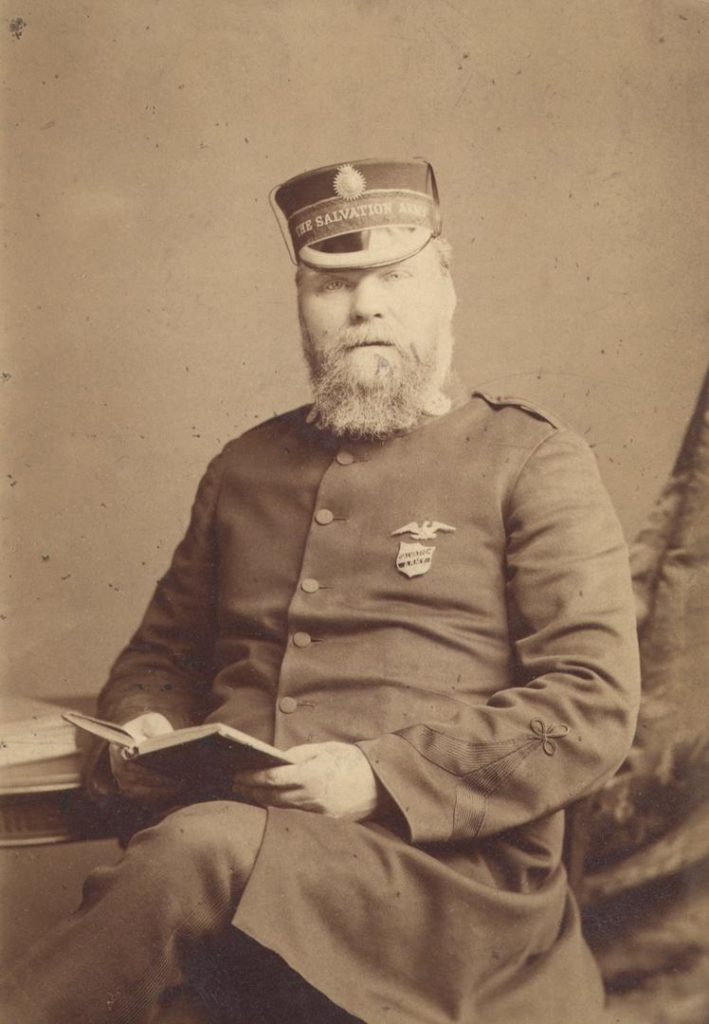
RESERVE AND MILITIA MOBILIATION TESTED
In April there was a major mobilisation exercise called for the whole of the Reserve and Militia. This would test how long it would take the reserves, both the volunteer element and those serving the remaining of their Colour Service with the reserve, to assemble, be kitted out and then dispersed to their defence locations or for deployment abroad. It involved medicals, especially for the reserves who did not parade regularly but would only be called out in a National emergency. The Devon Artillery Militia was involved along with thousands of men who were travelling throughout the country to their assembly points.
PROMENADE PIER ORDINANCE PASSED
Although plans and designs for a pier had begun to be drawn up 1875 it was only when the local Ordinance, the Plymouth Pier Order had been passed in 1878 that the work could go ahead. Initial pilings were started in 1880 although the original design had to be changed as the planned Pavilion on the pier would obscure the view of Drake’s Island. However all was soon in place and a Glasgow contractor, Laidlaw, Sons and Caine was appointed who hoped to have the work complete by 1881. Unfortunately financial problems meant only ten iron columns were in place by then and the pier wouldn’t open until 1884 after a change of contractor.
THE SECOND ANGLO AFGHAN WAR
Africa, where Britain was carving out an Empire wasn’t the only place Britain was embroiled in conflict. It was another conflict where Britain had no great interest other than to stop another Empire expanding their influence, in this case Russia. The Amir of Afghanistan accepted a Russian diplomatic mission but refused to accept a British mission. This sparked a British military response. In November 1878 a British force of around 50,000 mostly Indian troops invaded in three columns. British victories at Ali Masjid and Peiwar Kotal left Kabul undefended. The Russians unwilling to intervene so when the old Amir died and was succeeded by his son a peace treaty was signed in May 1879. Later in the year an uprising that began with the killing of the British Representative in Kabul started and wasn’t put down until the British won the Battle of Kandahar in 1880. The British installed a new Amir and withdrew all their forces from Afghanistan by 1881. The region was relatively stable and in 1893 an agreement was signed defining the border between British India and Afghanistan. This became known as the North West Frontier and later became part of Pakistan. A number of the Artillery Garrison detachment on the Island in 1881 served in the conflict.
1879 ANGLO ZULU WAR
Back in Africa the British were trying to expand both influence and Empire. The British High Commissioner Sir Bartle Frere sent an ultimatum to the independent King of Zululand Cetshwayo essentially demanding that Zululand become a puppet state. Unsurprisingly this was rejected and the British invaded. The first invasion by three British columns was a disaster and included the heavy British defeat at Isandlwana although Zulu casualties at other battles were high and had an effect after the British regrouped and invaded a second time. King Cetshwayo wished to negotiate but the British refused and inflicted a decisive defeat at the Battle of Ulundi in July, the King was captured the following month. The tribal chiefs then submitted to British rule and Zululand was divided up into thirteen chiefdoms to prevent the unification of the Zulu Kingdom.
ROUTLEDGE NEPHEWS ORPHANED BUT THERE IS HAPPIER NEWS
January 1879 must have been a difficult month for the Routledge’s. Mary Ann, Richard’s with lost her brother William in what appears to have been an accident at sea off Babbicombe near Torquay. Richard wrote a letter to the Western Morning News which thanks people for their efforts and kindness to the 6 newly orphaned children. It is not clear if William was a widower when he died or if his wife died in the same accident. Military life carried on for Richard as the Regimental Sergeant Major and in May he was one of the judges at the Devon Artillery Militia Sports Day at Tregantle Fort as part of their annual camp which also included some training on the Island. In June the Island Garrison detachment formed from 7th Battery, 8th Brigade was inspected. The report has the first mention of a library on the Island. Around the same time there was a much happier event for the Routledge’s when there was a summer wedding between John, Richard and Mary Ann’s second son and Mary Cox, a local lass from Devonport. John would have just finished training on HMS Impregnable and be ready to leave for his first ship.
ISLAND CASEMATES FINALLY RECEIVE BLAST SHIELDS
In June the 9 inch 12 ton Gun carriages were fitted with traversing gear and the Iron Blast Shields were finally put in place. A report in the news shows how an Officer could impact the men under his command for good or bad. Fortunately for the detachment on the Island at the time it was for good. Their Officer Commanding was Lieutenant A H Simpson who it appears supplied wet weather gear of the crew of the Island Boat and helped with other recreations and amusements. By September Number 19 Battery of 20th Brigade were supplying the Island Garrison detachment of 1 Officer and 30 Other Ranks.

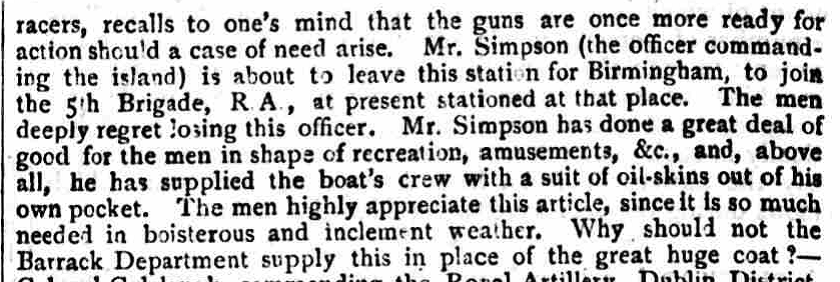
1880 BRINGS MORE JOY FOR THE ROUTLEDGE’S
During 1880 62 George Street was becoming ever more crowded as William and Caroline had their fourth child, a boy Sydney Robert. Newly married John and Mary had a baby girl they christened Beatrice Mary and there was another wedding. Mary Jane, the eldest daughter and third born of Richard and Mary Ann’s children married Charles Henry Maynard. He and Mary Jane moved in to 13 George Street just up the road from William and Caroline. Charles was a local man and Shipwright working in the Dockyard. It seems the Routledge’s were doing well for themselves as Richard could afford a yacht which the family presumably sailed in the Sound. In May he appeared in Court as a witness in a case bought against Henry Bawden for wilfully damaging the family 7 ton yacht. The case was sent to trial but I don’t have the final outcome. Later in the year Mary has their first child, a baby girl she and Charles call Ethel Phyllis. Over on the Island 8th Brigade have replaced 20th Brigade as the unit supplying the Island Garrison. They in turn are replaced by 7th Brigade later in the year.
In December Gunner Janes Welsh had his Christmas ruined as he was Court Martialled for Desertion from Drake’s Island on 31st August and making away with his kit. Gunner Welsh was caught in Lancaster and handed back to the Military on 11th December. He pleaded guilty.
THE FIRST BOER WAR
With the defeat of the Zulu Kingdom the British in Africa came into conflict with the Boers, descendants of earlier settlers who had their own independent states in South Africa some of which had already been annexed by the British. Hostilities began when a British Official seized a wagon from a Boer who refused to pay a tax which was probably illegally inflated. The wagon was due to be auctioned off to pay the tax but armed Boers seized the wagon by force. The Transvaal which had been annexed by the British declared independence and the Boers adopted irregular guerrilla tactics. They were so successful that they inflicted the first defeat on the British since the American War of Independence. A peace treaty was signed in March 1881 which gave the Transvaal self-governance under the Boers but remained part of the British Empire.
THE 1881 CENSUS ON THE ISLAND
The 1881 Census was taken on 3rd April. The return for the Island showed there were 64 people living on the Island. There was the Master Gunner and his assistant. A 48 man detachment from 7th Brigade of the Royal Regiment of Artillery and the Canteen Lessee. The detachment was commanded by Lieutenant William Taylor who had Staff Sergeant Thomas McDonnell as his 2ic. There were 3 Sergeants, 3 Corporals, a Bombardier and 39 Gunners. The Garrison was predominantly Irish with 19 Irishmen serving, no Scots or Welsh but 4 were born in overseas territories and the remainder spread across 14 English Counties. There were 6 military families quartered on the Island and the family of the Canteen Lessee. Within the families there were 4 girls and 2 boys. The following lists the Garrison and what information, if any, I have found on them. A number served in the previously mentioned conflicts.
Lieutenant William R Taylor; aged 23; Unmarried; born on Corfu. William enlisted as a Cadet in August 1876 and was promoted to Lieutenant in 1878 receiving a further promotion to Captain in 1886.
Staff Sergeant Thomas McDonnell; 24; Unmarried; Ireland.
Sergeant John Foley; 40; Unmarried; Ireland.
Sergeant Patrick Whittle; 28; Married; Ireland. Although Patrick was married to Mary at the time of the census he was unaccompanied on the Island. They had one son, Christopher who was aged 2 at the time and would go onto have another two children John, born in 1884 and Ellen born in 1887. All were born in Ireland so it’s possible the rest of the family was in Ireland. Patrick was still serving in 1891 and the family was living in Coventry.
Sergeant Robert Durant; 29; Married; Ireland. Robert was posted to Fort Hubberston in Pembroke after his stint in Plymouth. Whilst there he and Margaret had another four children, Margaret in 1882, Robert Michael in 1884, Kathleen born in 1887 and Clara born in 1889. The family was still in Fort Hubberston for the 1901 census. He had left the military by 1911 and was running the Whiteleaf Pub in Princes Risborough, Buckinghamshire. Kathleen was helping them run the Pub and Clara was away training as a Nurse. Margaret died in 1927 but Robert was living with both Kathleen and Clara who hadn’t married in Woking, Surrey where he died in 1945.
Margaret Durant; 23; Wife; Devon.
Helen M Durant; 2 months; Daughter; Plymouth, Devon.
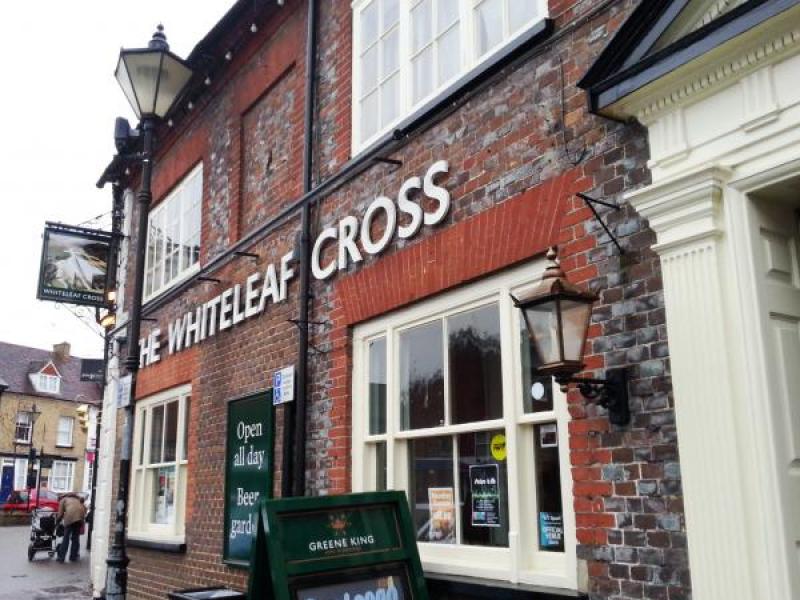
Corporal Thomas Bray; 26: Unmarried; Nuffield, Surrey. Thomas married Selina who hailed from St Budeaux in 1881. He was living in Ivybridge as a pensioner in 1901.
Corporal Frederick Saunders; 23; Married; India. Eliza Saunders; 23; Wife; Ireland.
Corporal Lionel G Millard; 37; Unmarried; Postwick, Norfolk. Lionel had left the military by 1891. He married Margurite who was from Southwark and was working as a Railway Detective. The Railway companies employed their own detectives as there was no Railway Police at the time.
Bombardier Stephen Mayes; 28; Unmarried; Middlesex, London. Stephen enlisted in 1872 and immediately deserted remaining on the run until 1874. He then spent the next 5 years in India and seemed to adapt to military life. He was promoted to Bombardier just before the Census. He was subsequently promoted to Corporal just after the census and married Fanny Louisa Roberts, a Plymstock lass in Plymouth. He was promoted again to Sergeant in 1883 and was serving in Durham during the 1891 census. He had left the military by 1901 and was living in Lower Hooe working as an Oil Merchant. He was working as a caretaker and living at Ivybridge with Fanny in 1911. He died at Yealmpton in 1943 aged 88. It seems they never had children.
Gunner Edward Adams; 19; Unmarried; Dunstable, Bedfordshire. Edward enlisted in 1880. He was posted to India from 1881 to 1888 and took part in the Burma Campaign in 1886. He was promoted to Bombardier in 1887 but tried and reduced back to Gunner a year later. He married Sarah after he was discharged and was working as a Barman in Lambeth, London during the 1891 census. They had their first child Daisy in 1901 when Edward was working as a Brewer’s Drayman. A second daughter, Miriam, was born in 1903 and the family was still in London during the 1911 census.
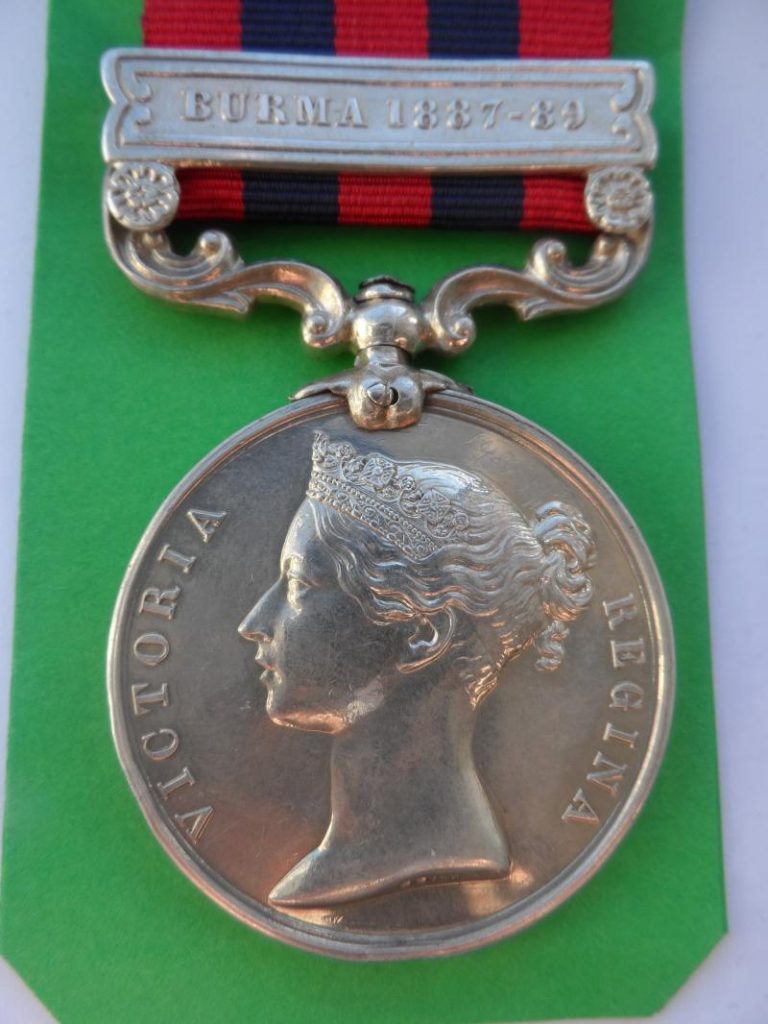
Gunner Edgar Bloomfield; 25; Unmarried; Ufford, Suffolk. Edgar enlisted in October 1880 and along with recruits of his age was vaccinated in infancy. He was promoted to Bombardier in 1886 when he was posted to Malta. He was then promoted to Corporal in 1887. The following year he was tried by Court Martial and reduced in rank to Gunner. He was then transferred to the 1st Class Reserve for the remaining 4 years of his engagement. In 1891 he was living with his Mother and Stepfather who was a farmer back in Ufford. He was working as a Carter working the horse and cart to take produce to market. In 1908 he married Harriet and passed away in 1934.
Gunner John Borstable; 19; Unmarried; Ireland.
Gunner Willy Brewer; 19; Unmarried; Boughton, Suffolk. Willy first enlisted in the Militia then transferred into the Artillery in 1880. He was posted to India from 1883 to 1888 when he returned to Britain and was transferred to the 1st Class Reserve for the remaining 4 years of his engagement. He married Betsy Hammond in Suffolk a year later. Along with many other recruits at the time he was discharged with a Certificate of Education which was becoming a requirement for promotion.
Gunner Timothy Brown; 22; Unmarried; Ireland. Timothy was another 1880 recruit. His engagement was the same as other recruits of the time. An initial 12 years with the option of 4 in the Reserve. At the end of the first 12 years there was the option to serve for another 12 years. He was unusually tall for the time at 6ft 2in tall. He was posted to India in 1881 where he was tried at a court martial and imprisoned. He was discharged as medically unfit in 1884 with what was described as a General Disability. He intended to live in Glasgow.
Gunner Edward Brown; 19; Unmarried; Heligoland.
Gunner Samuel Cooper; 20; Unmarried; Manchester, Lancashire. Samuel was another who enlisted in 1880. He served 8 years before being transferred to the 1st Class Reserve. He was working as a Striker in a Manchester Ironworks during the 1891 census and released from the Reserve a year later. In 1900 he enlisted in the newly formed Royal Garrison Artillery on a short 1 year engagement and was discharged in Sheerness in 1901. There is no record of Samuel marrying.
Gunner Patrick Donaghy; 43; Unmarried; Ireland. The only information regarding Patrick is he was serving in the Artillery in Shanghai, China in 1861 and was then in Woolwich, the Artillery Depot in 1871. He must have been near the end of his service at Plymouth which would most likely have been his last posting.
Gunner William Dwyer; 26; Married; Ireland. William enlisted in 1872 aged 18 and married Mary Judge in 1880. They had five children after they left the Island. Thomas in Shorncliffe during 1882, the family was then posted to Christchurch where Edward was born in 1883. They were subsequently posted to Portsea where Margaret and Henry were born in 1885 and 1888 respectively. They were in Woolwich when Charles was born in 1892. Henry then applied for his discharge as of right in 1894 when he was released from the Artillery.
Mary Dwyer; 20; Wife; Ireland.
Gunner Ambrose Griffiths; 18; Unmarried; Dunster, Somerset. Ambrose had a 26 year career beginning in 1880. He married Kate Saunders at Stonehouse in 1893 with whom he had 5 children. Alice in 1884, William in 1885, Percy in 1887, Lillian in 1891 and finally Florence in 1893. It seems he was extended beyond the normal 21 years service as he was a Mason’s Labourer and was used to assist workmen in the construction of fortifications. He was discharged in 1906 in the Isle of Wight where he settled. In 1911 he was working as a caretaker in Freshwater and moved to Yarmouth where he worked as a jobbing gardener. He passed away in Yarmouth in 1939.
Gunner Henry Denison; 46; Widower; Debden, Essex. Henry enlisted in 1861 aged 25. He spent time in India from 1862 until 1968. He took part in the Abyssinia (current day Ethiopia) campaign in 1868 for which he received the Abyssinia Medal before returning to India. He then took part in the Bhutan Campaign for he which he received the Campaign Medal before returning to Great Britain in 1872. He was then posted to China from 1876 to 1880 before returning to Britain. After Garrison duties on the Island he was posted to Pembroke and married Betty there in 1883 before being discharged in 1891. He intended to stay and live in Pembroke.

Gunner Thomas Davell; 24; Unmarried; Ireland.
Gunner William C Green; 23; Unmarried; Middlesex, London.
Gunner Joseph Flynn; 36; Unmarried; Ireland. Joseph spent 2 years in the Militia before transferring to the Artillery in 1866. He was posted out to India in the same year and was out there until 1878. During his time in India he was tried by court martial and imprisoned in 1868 and served with the Perak Field Force against the Malays for 2 years between 1875 and 1877. Joseph was discharged in 1886 as unfit for further service with a pension of 12d per day. He intended to live in Dublin.
Gunner John Miles; 42; Unmarried; Brighton, Sussex.
Gunner John Stone; 41; Unmarried; Weston, Herefordshire. John enlisted in 1859 and was discharged just after his stint on the Island in 1881. He was tried and imprisoned twice early in his career in 1861 and 1862. He was then promoted to Bombardier in 1864 and Corporal in 1866 before being tried again and being reduced in rank and imprisoned. He was tried again in 1872 and received another spell of imprisonment.
Gunner George Jeffery; 26; Unmarried; Crowthorne, Somerset.
Gunner Edward McElroy; 38; Unmarried; Ireland. Edward was a tailor by trade before enlisting in 1861. He served over 12 years abroad in India, St Helena and South Africa where he received the 1879 campaign medal for the 1st Boer War. He was discharged at the end of his engagement in 1882. He was not married and intended to live back in Ireland.
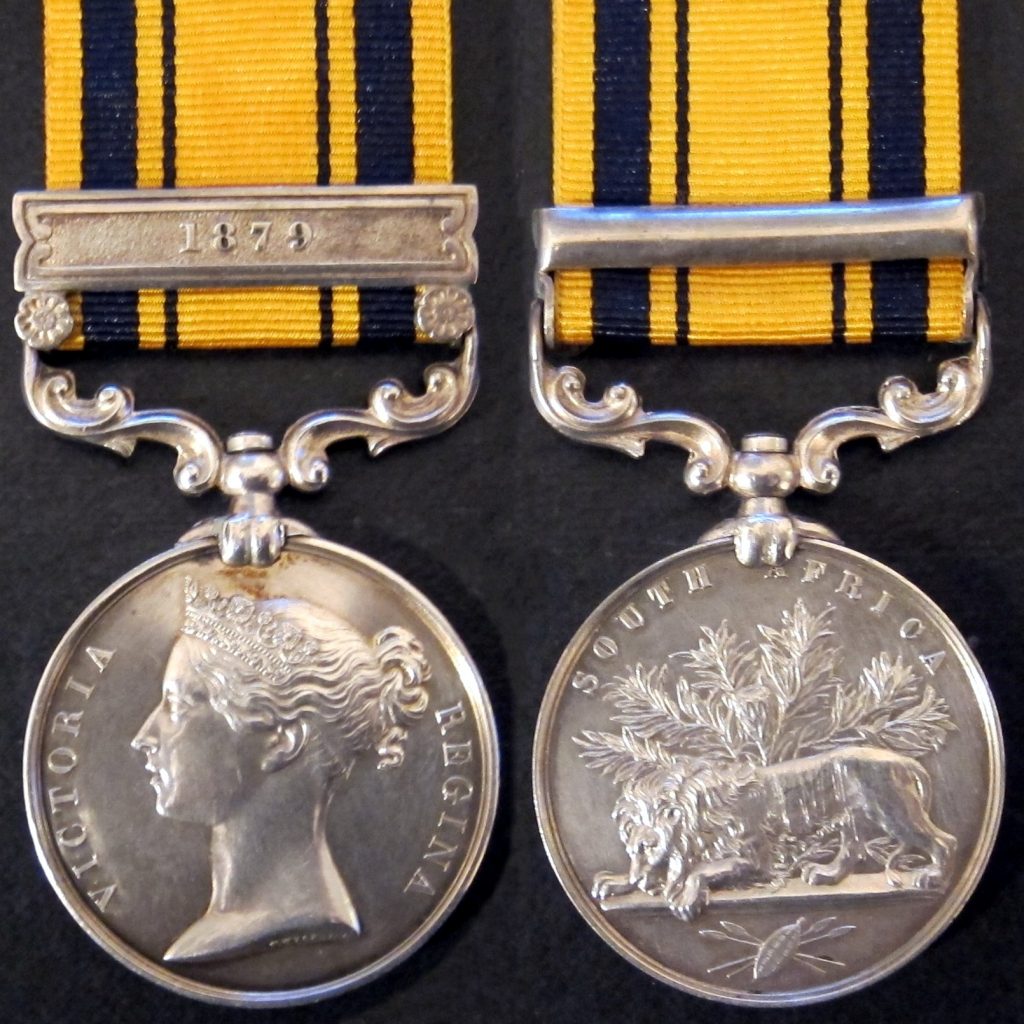
Gunner George Spellissy; 39; Married; Ireland. Annie Spellissy; 38; Wife; Ireland.
Gunner Richard Criddle; 29; Married; Axbridge, Somerset. Catherine Criddle; 24; Wife; Ireland. Elizabeth Criddle; 2; Daughter; Ireland. James Criddle; 6 months; Son; Plymouth, Devon
Gunner James Muldron; 20; Unmarried; Ireland.
Gunner James Harper; 28; Unmarried; Woolton, Lancashire.
Gunner Harry Hacker; 23; Unmarried; Heligoland.
Gunner Robert Hayes; 18; Unmarried; Ireland.
Gunner George Hayes; 19; Unmarried; Ireland. George was a Militiaman in the Mid Ulster Artillery before transferring to the regulars in 1880. He married Maggie Louisa Bell in 1883 at Dover. They had 4 children, George in 1894 at Dover, Eliza in 1887 and Robert in 1889 both in Malta and finally William in 1892 at Weymouth. Unfortunately tragedy struck and both Robert and William died on the same day in 1892 presumably in an accident but I have no details of what happened. They had another two children, Mary in 1895 at Weymouth and John at Seaforth in Lancashire during 1897. George was discharged in 1901 as medically unfit, he was being treated in a Lunatic Asylum at the time, with a pension of 13d per day for life. He seems to have made a recovery and as working as a labourer in Seaforth during the 1911 census and still living with Maggie and a couple of the kids.
Gunner Henry H Brown; 19; Unmarried; Worthing, Sussex.
Gunner William Bagly; 18; Unmarried; Abbotsbury, Dorset.
Gunner William Stroker; 25; Unmarried; Ireland. William enlisted in 1878 and by 1879 had been court martialled and imprisoned. However by 1884 he had made Bombardier and was promoted to Corporal in the same year. He transferred to the Reserve in 1886 and intended to live in Roscommon in Ireland.
Gunner Edward Tinsley; 22; Unmarried; Wigan, Lancashire.
Gunner George Stevens; 28; Unmarried; Hampstead, Middlesex.
Gunner Thomas Scrase; 23; Unmarried; Brighton, Sussex.
Gunner James Bell; 32; Unmarried; Ireland. James enlisted in 1872. He spent 1873 to 1878 in India and transferred to the Reserve just after his stint in Plymouth in 1882 but was immediately recalled to the Colours. Once recalled he was arrested as a deserter having previously enlisted under the name James Collins. He was convicted at Court Martial and imprisoned then discharged in 1883 after completing his time in jail.
Gunner William Browning; 26; Unmarried; Shenley, Hertfordshire.
Gunner James Coffon; 29; Married; Ireland.
Gunner Thomas Daly; 37; Unmarried; Manchester, Lancashire.
Gunner Patrick Flanagan; 47; Married; Ireland.
Gunner John Fox; 39; Unmarried; Taunton, Somerset.
Gunner Thomas Foyle; 21; Unmarried; Heylesbury, Wiltshire. Thomas enlisted in 1879 aged 19. He was discharged in 1885 as medically unfit with a heart condition and was awarded a pension of 8d per day for 18 months.
Gunner Frederick Fenick; 26; Unmarried; Harrisham, Kent.
Master Gunner Anthony Carter; 41; Married; Ireland.
Gunner Charles Dawkes; 37; Married; Wiston, Northamptonshire. The only further information I have for Charles is that he was discharged by the time of the 1891 census. He was living in Tavistock Road and working as a Milkman. Elizabeth Dawkes; 31; Wife; Altarnun, Cornwall. Ellen Wallace; 8; Sister; Altarnun, Cornwall.
Mary E Burridge; 21; Unmarried; Canteen Stewardess; Portsmouth, Hampshire. Martha Burridge; 19; Unmarried; Sister; Shoeburyness; Essex. Alice M Burridge; 6; Sister; Dover, Kent. Joseph Burridge; 3; Brother; Plymouth, Devon.
I hope you have enjoyed reading about the Routledge’s, the Island and the Three Towns during the 1870’s. The next blog takes us from the 1881 census through to the 1891 census

